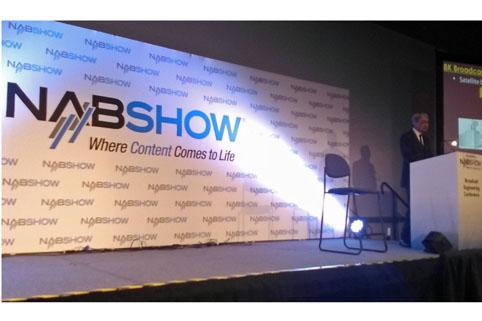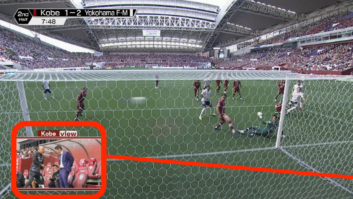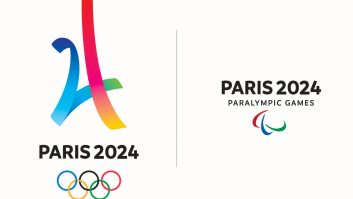
Japanese public broadcaster NHK announced plans last year to begin trialling 8K broadcasts in 2016, in time for the 2020 Tokyo Olympics. At this week’s NAB, NHK is exhibiting the latest 8K equipment as well as a 350-inch 8K theatre, allowing visitors to its booth to experience ultra high definition 8K images and 22.2-multichannel 3D sound. The NAB conference opened in Las Vegas yesterday and NHK’s Masayuki Sugawara took to the stage to discuss the company’s plans in the session, ‘UHDTV roadmap for ultimate 8K from 4K’.
Masayuki began by outlining the evolution of broadcast media in Japan, with the most recent stages focussing on the development on 8K Super Hi-Vision. This means more pixel, faster pixels (frame rate of 120Hz), and better pixels (12-bit/pixel and wide colour gamut). More pixels, explained Masayuki, will produce a “strong sense of reality” as “the wider the field of view becomes, the sensation of reality for the viewer increases.” Approximately 8,000 pixels are needed, so 8K is “the ultimate image format for 2D television.” Faster pixels, ie. increasing the frame frequency to 120Hz, will improve motion portrayal, and better pixels means expanding colour gamut “so that almost all surface colours can be reproducible”.
High dynamic range is a “hot topic right now,” asserted Masayuki. “There are various points of view in the discussion” but without “sufficient time to talk about them” during the half-hour conference session, he asserted the broadcaster’s dedication to its 8K roadmap, simply stating, “NHK is seriously considering how to improve the quality of TV images”.
The government set up a committee for the advancement of broadcasting services in 2012; the 4K test bed started in 2013; 4K testing began a year later; and 8K test broadcasting will commence in 2016, confirmed Masayuki. A short while after this, he continued, “4K and 8K broadcasting and programmes will be enjoyed on commercial TV sets.”
The Next Generation Television and Broadcasting Promotion Forum (NexTV-F) group was set up to promote this roadmap. To fulfil its goals, both domestic and international standards need to be established to allow for broadcasting to start, as well as parameter values set for HD TV systems for production and international programme exchange, including pixel count and frame frequency. Standards also need to be established for satellite broadcasting, which Masayuki said is “indispensible to begin 8K testing”.
NHK is “aiming at conducting regular broadcasting”, meaning “a required amount of practical system sets are needed for broadcasting”. The broadcaster has, for example, continued its R&D work to develop compact, lightweight cameras, three examples of which are on display at NHK’s booth at NAB. NHK is also “working on developing 8K equipment including OB vans, an editing suite and 22.2-channel loudness meter”. It has “taken the lead in 8K displays in the initial stages,” Mayasuki claimed, evident by the 85-inch screen Sharp TV (which debuted at CES earlier this year), and 13-3-inch OLED screen, both available for visitors to check out at NAB this week.
Improving programme quality is also crucial before the 2016 testing begins. Super Hi-Vision trials were conducted during the 2012 London Olympics and FIFA World Cup, though NHK aims to increase the variety of programming, including other genres in the trials such as national history programming. For the FIFA trials NHK had production crew at five venues in Brazil, three public viewing venues in Rio, as well as four in Japan. The broadcaster’s work trialling the technology continues, and NHK “has a desire to be on-site again next year for the Olympics”.
It seems the stage is set for the technology’s deployment next year, but what about beyond 2016? Satellite, cable and IP will be used for 8K testing in 2016, and “it is desirable to introduce terrestrial in the future,” said Masayuki. The Olympics will provide a “showcase of broadcasting technologies” allowing viewers not lucky enough to attend the event, to “really feel as if they are there”.
Masayuki concluded by confirming the next step in NHK’s roadmap happening this month. NHK’s Science and Technology Research Laboratories will hold an Open House, at which it will exhibit a satellite broadcasting system that uses 8K Super Hi-Vision technologies. As part of the continued development into the future of UHDTV, Masayuki told his audience to “keep an eye on this important step”.
N8933







